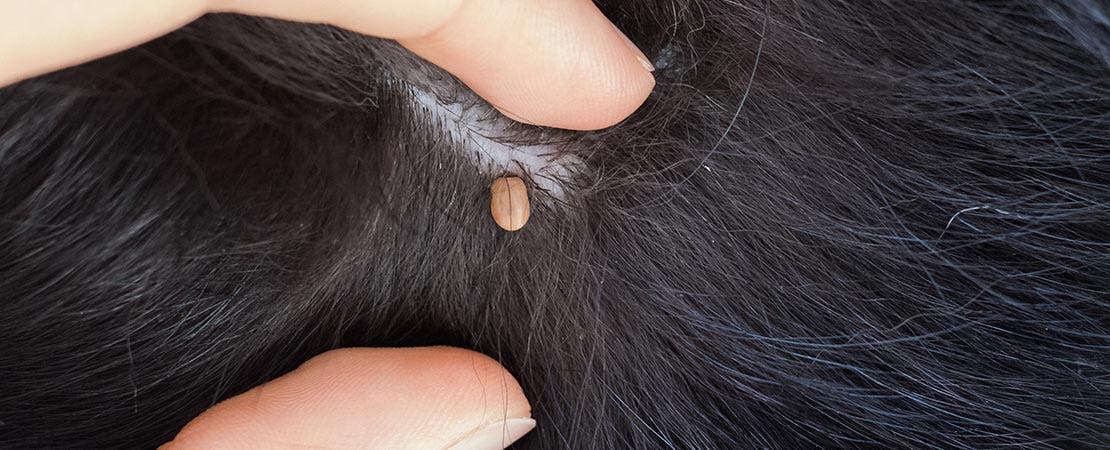Learn the difference between various bumps on your dog’s skin.
Have you ever felt something different on your dog’s skin during a play or petting session, such as a change in texture or even lumps or bumps? These may be a harmless skin tag or scab, but sometimes they can indicate a tick bite. It’s important to identify a tick early on so you can remove it as soon as possible. The longer your pet has a tick attached, the higher the risk of your pet contracting a tick-borne disease.
In this short guide, learn how to tell if your dog has a tick, a scab or a skin tag so you can help keep your pet healthy.
How to Tell If Your Dog Has a Tick or a Scab
Ticks are parasites that can easily latch onto your dog’s skin while they’re enjoying the outdoors. A tick simply positions itself on top of a blade of grass and uses its front legs to detect and hop on a passing host.
Ticks change in appearance as they feed. They initially appear as small, dark brown spots, but grow in size and become engorged as they feed. A feeding tick could easily be mistaken for a scab.
If you’re unsure whether your dog has a tick or a scab, part your dog’s fur and look closely; scabs are usually flat against the skin, but ticks stick out, especially as they grow in size.
Where Do Scabs on My Dog Come From?
Dogs love to explore their environment, running through the woods, chasing a ball or going on a long walk. It’s only natural that they’ll pick up a few cuts and scrapes along the way.
However, some scabs can indicate more treatment is needed:
- Allergies: If your dog is allergic to something, this irritation can cause them to scratch the itch, inflaming and damaging the skin, which can lead to scabbing.
- External parasites: Tick bites can sometimes irritate dogs, leading to scratching that can break the skin. Fleas also pose a problem: Some dogs are allergic to flea saliva, a condition called flea allergy dermatitis (FAD), triggered by flea bites. FAD causes intense itchiness so dogs often scratch and bite their skin excessively to relieve the itch, which can cause scabs.
How to Tell the Difference Between a Tick and a Skin Tag on Your Dog
Could that bump on your dog’s body be a skin tag, or is it a tick? Here’s how you can tell the difference between a tick and a skin tag:
- Color: Skin tags tend to be the same color as your pet’s skin, while ticks are often dark brown or gray in color. Spotting a tick can be straightforward if your pet has light-colored skin and fur; you may need to take a closer look using a magnifying glass if your dog has darker skin and fur.
- Legs: Ticks are part of the arachnid family, so just like spiders, adult ticks have eight legs you should be able to see upon close inspection.
- Movement: Even an attached tick will move its legs when provoked. Try touching the tick with a gloved finger and watch to see any legs moving. If the tick isn’t attached, it may run away from you, so be careful to examine your pet outside your home just in case you lose sight of the pest.
- Growth: If the bump gets bigger over a period of a few days, it’s more likely to be a tick rather than a skin tag.
Still can’t tell? If you’re not sure if the small bump is a tick or a skin tag, ask your vet to check it to be on the safe side.

Should I Worry about a Skin Tag on My Dog?
It’s a good idea to visit your vet to examine any skin lumps you’re concerned about on your dog to rule out anything serious. If your vet confirms it is a skin tag, in most cases, they’re a minor problem and nothing to worry about. Remember, never try to remove a dog’s skin tag yourself.
My Dog Has a Tick — How Do I Remove It?
If you find a tick, you’ll want to remove it right away. Ticks aren’t just a nuisance for your dog; they can also pass on serious tick-borne diseases, such as Lyme disease, to both your dog and to you.
Tick removal tools, such as a tick hook, are designed to easily and quickly pull out a tick from your pet’s skin. These tools can pry out the whole tick — including their mouthparts —unlike tweezers, which can leave bits of the tick in your dog’s skin.
Read our guide for step-by-step instructions on removing ticks from dogs.
Use Effective Tick Protection for Dogs
It’s extremely common for dogs to pick up ticks from the environment, especially if they’ve been running around wooded areas or through tall grass — a tick’s favorite place to hide in wait for their next host.
Now that you know what to look for, it’s smart to regularly check your dog for ticks, feeling for small bumps over the skin that could indicate a tick bite. Dog owners should also check themselves, in case a tick hitched a ride on them instead of their pet.
The most effective way to help protect your dog from biting ticks in the first place is to use a tick preventive product. Tick preventive products are typically available as collars, orals or topicals, so choose the option that works best for you and your pet.

Seresto® Flea & Tick Collar for Dogs
An easy-to-use, odorless, non-greasy collar that kills and repels fleas and ticks for 8 continuous months.

K9 Advantix® II
A convenient, monthly topical application that kills and repels fleas, ticks and mosquitoes through contact, so they don't have to bite your dog to die. Do not use on cats.







